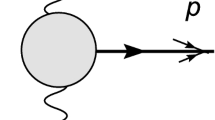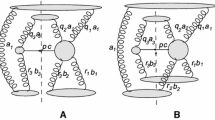Abstract
In the Regge kinematics the amplitude for gluon production off three scattering centers is found in the Lipatov effective action technique. The vertex for gluon emission with the reggeon splitting in three reggeons is calculated and its transversality is demonstrated. It is shown that in the sum of all contributions terms containing principal value singularities are canceled and substituted by the standard Feynman poles. These results may be used for calculation of the inclusive cross section for gluon production on two nucleons in the nucleus.









Similar content being viewed by others
References
M.A. Braun, Phys. Lett. B 483, 105 (2000)
M.A. Braun, Eur. Phys. J. C 48, 501 (2006).
Y.V. Kovchegov, K. Tuchin, Phys. Rev. D 65, 074026 (2002)
J. Bartels, M. Salvadore, G.P. Vacca, J. High Energy Phys. 0806, 032 (2008)
M.A. Braun, Eur. Phys. J. C 70, 73 (2010)
V.A. Abramovsky, V.N. Gribov, O.V. Kancheli, Sov. J. Nucl. Phys. 18, 308 (1974)
L.N. Lipatov, Phys. Rep. 286, 131 (1997)
M.A. Braun, M.I. Vyazovsky, Eur. Phys. J. C 51, 103 (2007)
M.A. Braun, M.Yu. Salykin, M.I. Vyazovsky, Eur. Phys. J. C 72, 1864 (2012)
M.A. Braun, L.N. Lipatov, M.Yu. Salykin, M.I. Vyazovsky, Eur. Phys. J. C 71, 1639 (2011)
M. Hentschinski, J. Bartels, L.N. Lipatov, arXiv:0809.4146
M. Hentschinski, Acta Phys. Pol. B 39, 2567 (2008). arXiv:0908.2576
Acknowledgement
This work has been partially supported by the RFFI grant 12-02-00356-a.
Author information
Authors and Affiliations
Corresponding author
Appendices
Appendix A: Calculation of the induced vertex
We denote the term

as
for brevity.
We have to calculate the convolution of the induced vertex with the polarization vector of the gluon. Then the common factor
includes (−1) from (A.1), i for the vertex, −g 3 from (22), (−i)5 from fields, \(-q^{2}_{\perp}\) from \(\partial^{2}_{\perp}\), (−i)3 from three derivatives \(\partial^{-1}_{-}\) and the component \(\epsilon^{*}_{-}(p)=-2(p\epsilon^{*})_{\perp}/p_{+}\) of the polarization vector is correspondent to V −.
Suppressing the factor (A.2) and collecting similar terms, for the vertex we get

Further, using these identities:

we get

We can rewrite (A.4) in the form of the expression containing the factor p −=q 4− in the denominator of each term with the use of the identities

which are consequences of the relation q 1−+q 2−+q 3−+q 4−=0. Besides, we note that the T-matrices in the numerators form commutators [T a,T b]=if abc T c. This gives

for the vertex, where, for example, \(f^{12c}\equiv f^{b_{1}b_{2}c}\).
Arranging the T-matrices in the commutators once and once more and substituting \(\mathop {\mathrm {tr}}([T^{a},T^{b}]T^{c} )=\frac{i}{2}f^{abc}\), we get

Restoring the original notation and taking into account the factor (A.2), we finally get the answer

On the mass shell of the induced gluon the factor \(p_{+}p_{-}=-p^{2}_{\perp}\) appears in the denominator, therefore the vertex remains finite in the limit p −→0.
The vertex can be expressed in the more convenient form. With the use of the Jacobi identity \(f^{bcd}f^{b_{1}b_{2}c}=f^{bb_{2}c}f^{b_{1}cd}-f^{bb_{1}c}f^{b_{2}cd} \) and the relation
the sum of the first and the fourth term in (A.7) can be rewritten as the sum
With an analogous transformation of the rest terms, the vertex takes the form

The expression (A.8) is obviously symmetrical with respect to all permutations of momenta q 1,2,3 and correspondent indices b 1,2,3 of the induced reggeons.
Appendix B: Calculation of the four-reggeon vertex
Since the quadruple term tr([v +,v −][v −,v −]) is absent in the Yang–Mills Lagrangian, the four-reggeon vertex 〈A + A − A − A −〉 arises only from the term

of the induced part of the Lagrangian density (1).
To write the vertex in the momentum representation

we took into account the following factors: i for the vertex, g 2 from (B.1), (−i)4 from fields, \(-(q_{1} +q_{2} +q_{3})^{2}_{\perp}\) from \(\partial^{2}_{\perp}\) and (−i)2 from two derivatives \(\partial^{-1}_{-}\).
Suppressing the common factor and denoting the typical term as
we rewrite (B.2) in the form

Using the relation q 1−+q 2−+q 3−=0 and the identity
we get

In the original notation, restoring the common factor, we get finally for the vertex

The expression for the diagram from Fig. 6 is given by the four-reggeon vertex, multiplied by the Lipatov vertex, two reggeon propagators and the quark-reggeon vertex and equals

what coincides with (41).
Appendix C: Proof of transversality of the R→RRRP vertex
3.1 C.1 Effective vertex in an arbitrary gauge
To verify the transversality of R→RRRP vertex it is necessary to write for it the explicit expression in an arbitrary gauge. As was shown such an expression consists of several parts. The part corresponding to Fig. 4(1) is

The part corresponding to Figs. 4(2) and 4(3) is

The part corresponding to Fig. 4(4) is

The part corresponding to Fig. 4(5) is
So the total expression for V 5-effective vertex in an arbitrary gauge is equal to the sum of expressions (C.1)–(C.4).
3.2 C.2 Proof of transversality
To prove the transversality of effective V 5-vertex one should convolute an expression for it in arbitrary gauge with momentum vector p μ . We will do it separately for each of the parts (C.1)–(C.4). Part (C.1) convoluted with p μ gives

For (C.2)–(C.3) we correspondingly have


For (C.4) we have

Rights and permissions
About this article
Cite this article
Braun, M.A., Salykin, M.Y., Pozdnyakov, S.S. et al. Production of a gluon with the exchange of three reggeized gluons in the Lipatov effective action approach. Eur. Phys. J. C 72, 2223 (2012). https://doi.org/10.1140/epjc/s10052-012-2223-7
Received:
Published:
DOI: https://doi.org/10.1140/epjc/s10052-012-2223-7




